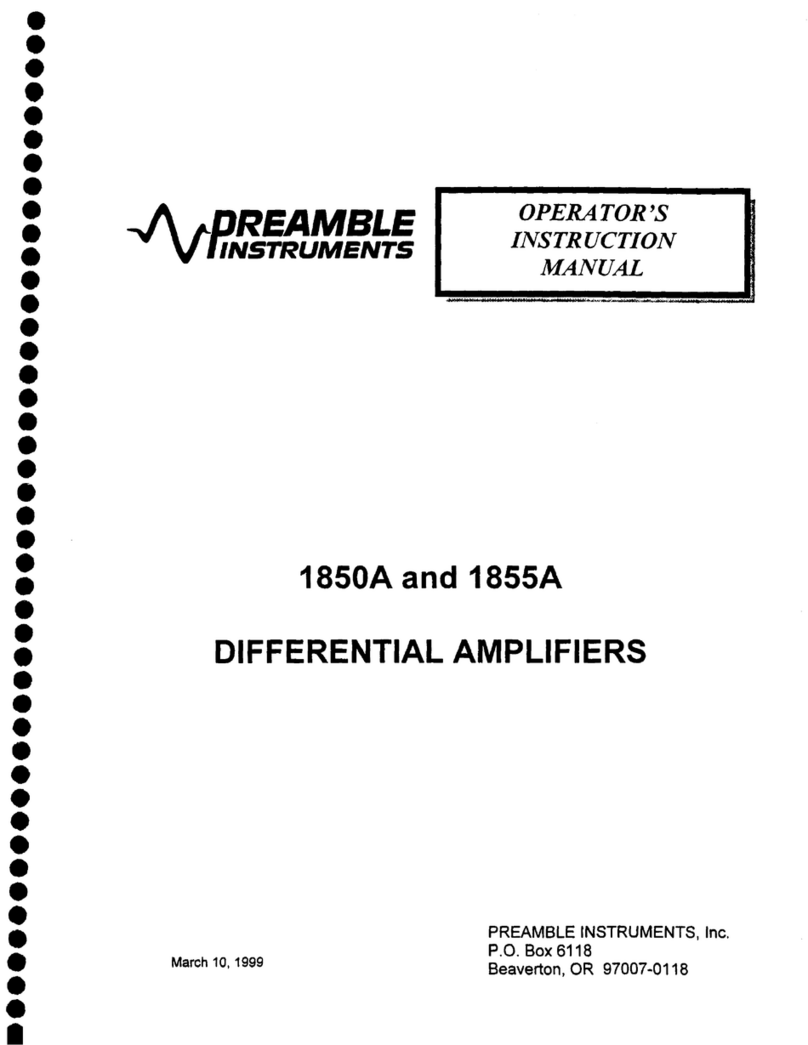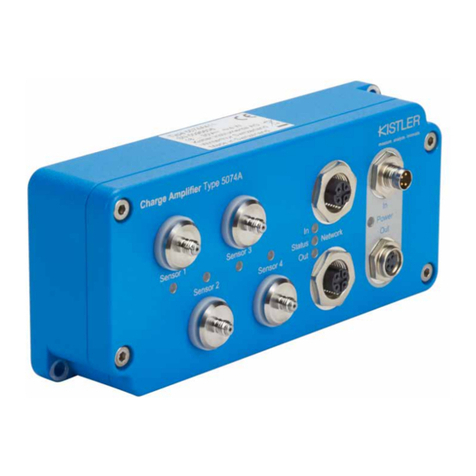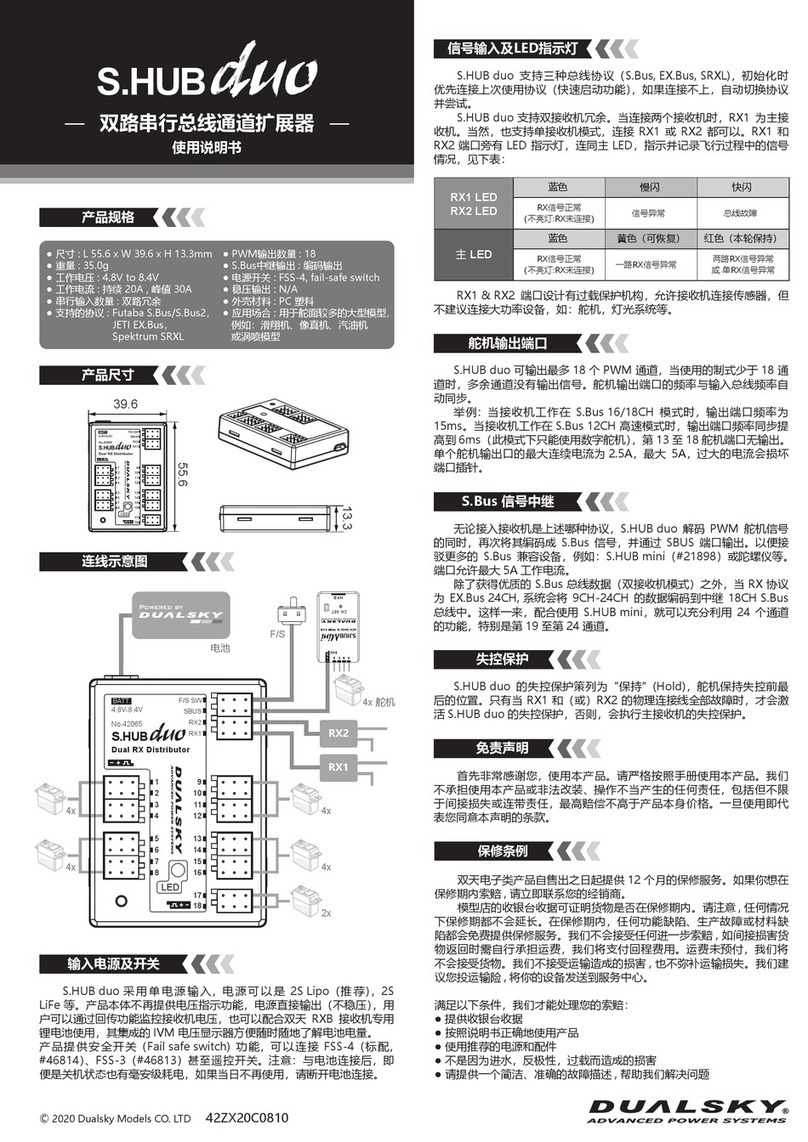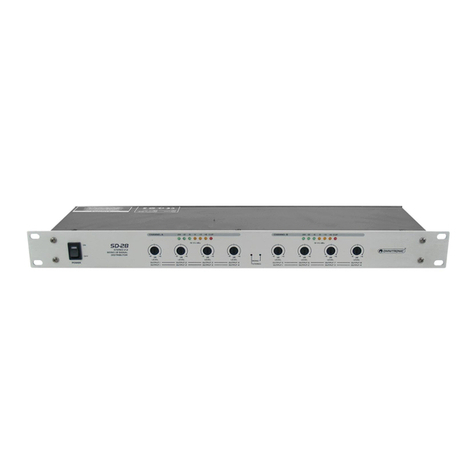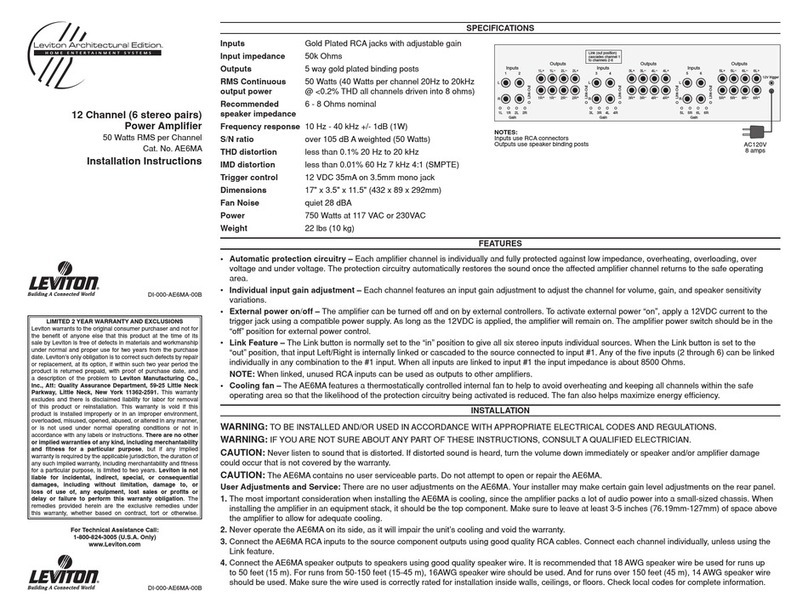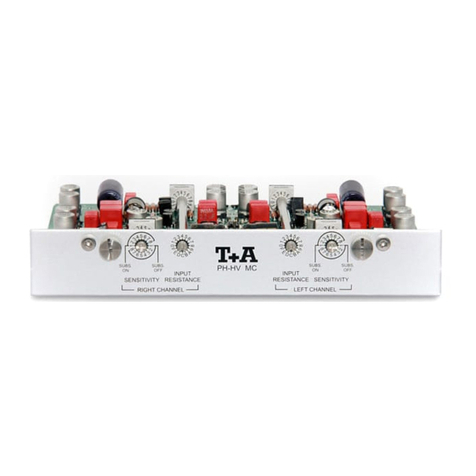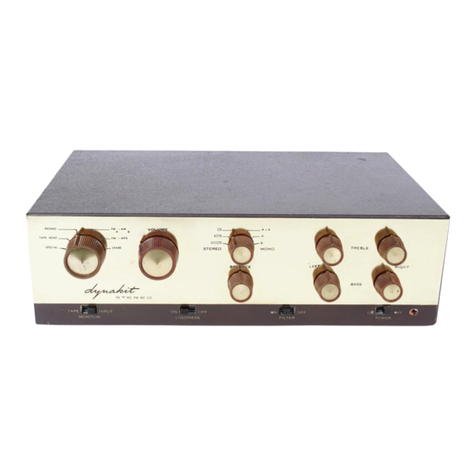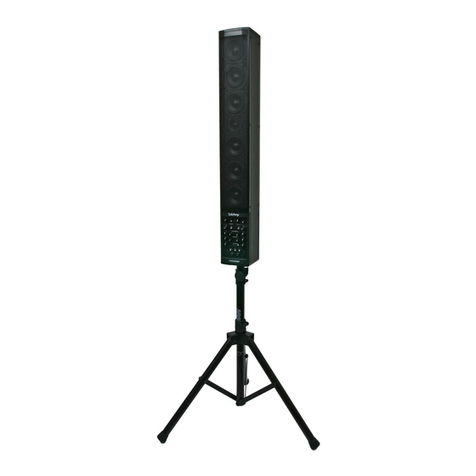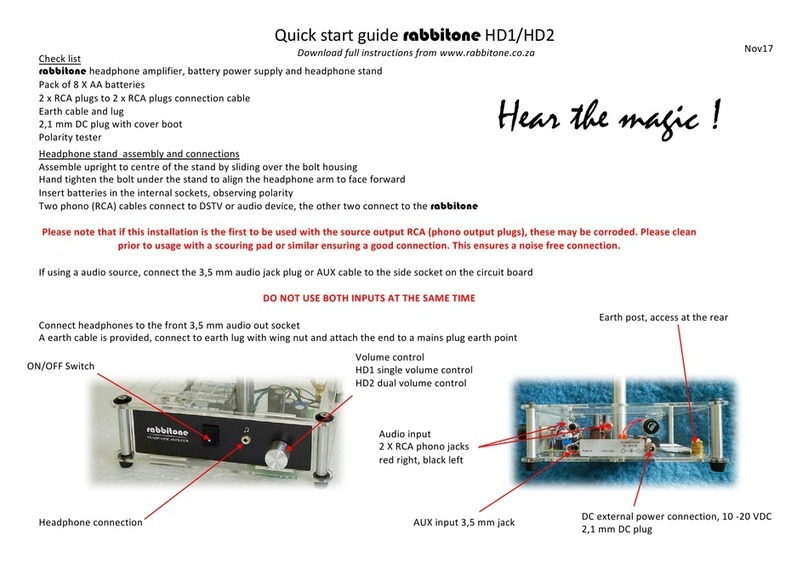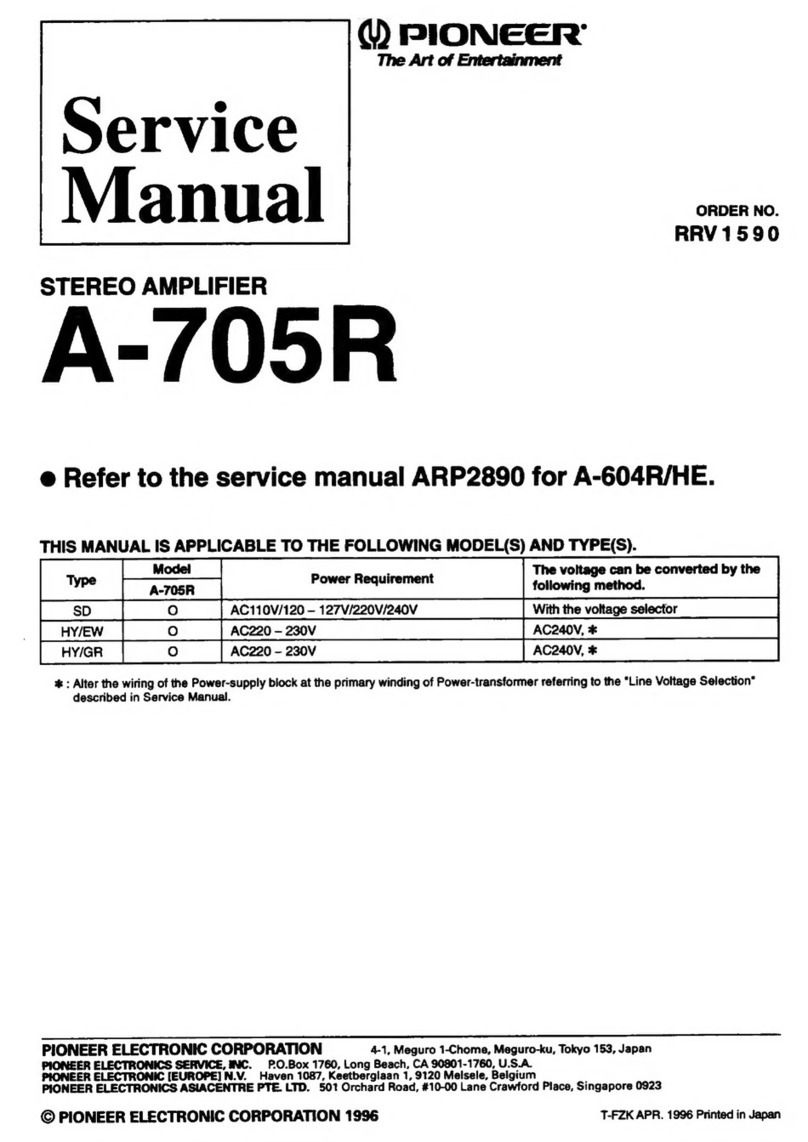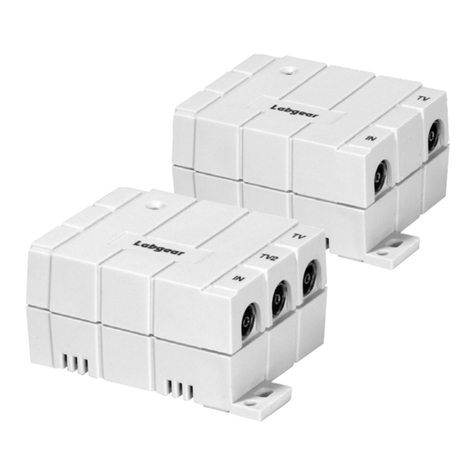Preamble Instruments 1820 User manual

-,~ ~OREAMBLE
-VIINSTRUMENTS OPERATOR’S
MANUAL
1820/1822
DIFFERENTIAL AMPLIFIER
RevisionD
August1999

Table of Contents
Section 1 Specifications
Introduction............................................................................. 1-1
1820/1822Specifications........................................................ 1-2
NominalCharacteristics.......................................................... 1-3
WarrantedandTypicalCharacteristics.................................... 1-4
EnvironmentalandPhysicalCharacteristics............................ 1-5
Section 2 OperatingInstructions, ControlsandIndicators
FrontPanel.............................................................................. 2-1
RearPanel............................................................................... 2-4
OscilloscopeSettings............................................................... 2-5
Model1820Operation............................................................. 2-6
Section 3 General Operating Information
GettingStarted......................................................................... 3-1
1822FrontPanelOperation..................................................... 3-1
ComparisonVoltageOperation............................................... 3-2
DifferentialOffsetOperation.................................................. 3-3
UserTrapstoAvoid................................................................ 3-4
Section 4 Performance Verification
Introduction............................................................................. 4-1
TestEquipmentRequired........................................................ 4-2
PreliminaryProcedure............................................................. 4-3
Procedure................................................................................. 4-3
1820/1822TestRecord.......................................................... 4-11
0
0
0
0
0
0
0
0
0
0
0
0
0
0
0
0
0
0
0
0
0
0
0
0
0
0
0
0
0
0
0
0
0
0
0
0
0
0
0
0
0
0
0
0

182011822Operator’sManual
Section 1
Specifications
Introduction
The 1820 and 1822 are stand-alone high performance
100MHzdifferential amplifiers. Theyare intended to act
as signal conditioning preamplifiers for oscilloscopes,
digitizers andspectrumanalyzers, providing differential
measurementcapability to instruments having only a
single-endedinput.
Thehigh gain of the 1820/1822can extend the sensitivity
of an oscilloscope with 1 mV/divto 1 laV/div. Abuilt-in
input attenuator maybe separately set to attenuate signals
by a factor of 10, allowing gains of 1000,100, 10, 1, or
0.1 and commonmodedynamicrange of +15.5 V(+1)
+155 V(+10). Optional probes further increase the
maximuminput signal and commonmode ranges in
proportionto their attenuationratio, but not exceedingthe
probe maximuminput voltage rating. Effective gain of
the 1822,including probeattenuation, amplifier gain and
attenuator settings, is automaticallydisplayed.
The 1820/1822 has a bandwidth of DCto 10 MHz,but
the operator can select froma full complementof high
andlow frequency-3dBpoints. In critical measurements,
the signal-to-noise ratio can be greatly improvedby
restricting the 1820/1822’sbandwidthto the frequency
rangeof interest.
The1822features a built-in Precision Voltage Generator
(PVG)that can be set to any voltage between+15.5volts
(+10 volts in Differential Offset) with 5 1/2 digit
resolution. Eachdigit of the voltage generator output can
be individually incrementedor decremented.Positive or
negative polarity can be selected. The PVGoutput can
be selected as an input to the inverting (-) input of the
amplifier for operation as a differential comparatoror
applied internally as a true differential offset voltage.
ThePVGvoltage is also available to be used externally
through a rear panel connector. In the 1820, this
connector becomesan input through whichthe user can
applyan external voltage to achievethe samedifferential
offset andcomparatorfunctions.
The 1820/1822 operates from 100 to 250 VACline
withoutline switching.
Awiderange of high performancedifferential probes are
available from Preamble Instruments for use with the
1820/1822. These include the +1 XC200low capacitance
probe, XCI00selectable (+10/+100) attenuation probe,
and the XC350+100 high impedance (92 M~/ 2.6 pF)
probe. Differential probeswith higher voltage ratings are
also available fromPreambleInstruments.
1-1

1820/1822Operator’sManual
1820/1822 Specifications
Except where otherwise noted, the following specifications apply to model 1820, 1822,
Differential Amplifiers.
Thespecifications are valid for instruments whenthe following conditions havebeenmet:
1820-PR2 and 1822-PR2
Theinstrument is beingoperated froma powersource whichmeetsthe line voltage and frequencyspecifications.
The instrument has been operating for at least 30 minutes in an environment which is within the operating
environmentalspecifications.
¯Theinstrument has been calibrated within the last 12 months.Calibration wasperformedin a controlled environment
of 25 +5°C.
NominalCharacteristics
Nominalcharacteristics describe parameters and attributes which have are guaranteed by design, but do not have
associated tolerances.
General
Input Configuration:
Offset Capability
+ Input CouplingSelections
- Input CouplingSelections
Input Connectors
MaximumNon-Destruct Input Voltage
Output Configuration
Output Impedance
Intended Output Load
Output Connector
Amplifier Gain
Input Attenuation
BandwidthLimit Filters (UpperLimit)
BandwidthLimit Filters (LowerLimit)
BandwidthLimit Filter Characteristics
Autobalance
Effective GainIndicator
(1822 and 1822-PR2models only)
TrueDifferential, + and- Inputs.
Precision Voltage Generator (1822 and 1822-PR2
models),or external offset reference source (1820
and1820-PR2models)can be selected as - input
source in VCOMPmode.
ThePrecision Voltage Generator (1822 and 1822-
PR2models),or external offset reference source
(1820 and 1820-PR2models) can be used
providetrue differential offset.
AC,Off (Precharge),
AC,Off (Precharge), DC, VcouP
BNC.+ Input incorporates Probe Attenuation
Codingsensing connector (1822 Only).
Withstands up to +250V.
Automaticinput disconnect with manualreset
Single Ended,Groundreferenced.
50
50f)
BNC
X1, X10, XI00, or X1000
+1 or +10
100 Hz, 300 Hz, 1 KHz,3 KHz,10 KHz,
30 KHz,100 KHz, 300 KHz, 1 MHz,3 MHz
0.1 Hz, 1 Hz, 10 Hz, 100 Hz, 1 KHz,10 KHz
Single pole, 6 dB/octave
Amplifierinitiates an automaticbalance cycle
wheneither gain button is depressed.
LEDsindicate the effective gain by factoring
ProbeAttenuation, Attenuatorand Gainsettings.
(Probes musthave codingconnectors.
+1, +10, + 100,and+ 1000probesare
recognized.)
1-2

182011822Operator’sManual
NominalCharacteristics (continued)
Dynamic Ranges
MaximumDifferential Linear Input:
X1000Gain, + 1 Attenuator
X100Gain, +1 Attenuator
X10 Gain, - 1 Attenuator
XI Gain, +l Attenuator
XI000Gain, +10 Attenuator
X100Gain, + I 0 Attenuator
X10 Gain,+ ! 0 Attenuator
XI Gain, +10Attenuator
MaximumCommonMode Input
+ 1 Attenuator
+ 10 Attenuator
Differential Offset Range(VD~FVMode)
(referred to input)
X10, X100, X1000Gain, + 1 Attenuator
X1 Gain, + ! Attenuator
Xi0, X100, XI000Gain, +10 Attenuator
X! Gain, +l 0 Attenuator
ComparisonOffset Range(VcoMPMode)
(referred to input)
+1 Attenuator
+ 10 Attenuator
Output Range
+5 mV
~
+50 mV
j
+0.5 V
1
+5 V
I
_+50mV
I
¯ +0.5V
l
+5 V
~
+50 V
t
+15.5 V
1
¯ +155V
l
¯ +!V
I
¯ +!0V
1
±10 V
l
±100 V
I
_+15.5V
I
¯ +i55V
I
Limitedto _+5Vinto 50 ~ load
t Voltagesare referred amplifier input connector.Multiplyby probeattenuation factor to obtain value refer to probe
input. (e.g. _+50mV
1 becomes+0.5Vat the probetip whenusing a +10probe.)
Precision Voltage Generator(1822 and 1822-PR2models
Output Range
Resolution
Control
Reference Type
Output Routing
Autozero
only)
±15.5 V
1 O0p.V
Individual incrementand decrementbuttons for
eachdigit. Digit carries overto next decade.
Ovenstabilized buried Zener
Canbe appliedto - input andavailable at rear
panel BNCconnector.
Removesoutput offset when0.0000volts is
selectedandperiodically thereafter.
Power Requirements
Line Voltage Range
Line Frequency Range
100 - 250 VAC
48 - 66 Hz
1-3

1820/1822Operator’sManual
WarrantedCharacteristics
Warrantedcharacteristics describe parameters whichhave guaranteed performance.
providedin the PerformanceVerification Procedurefor all warrantedspecifications. Unless otherwise noted, tests are
Gain Accuracy
Bandwidth(- 3dB)
X1or XI0 Gain
X 100 Gain
X 1000 Gain
Rise Time(XI or X10Gain)
CommonModeRejection Ratio
(X1 or X10 Gain)
70 Hz
100 KHz
1 MHz
Precision Voltage Generator Accuracy
+1%+ Uncertainty of termination resistance
>10 MHz
>2.5 MHz
>1 MHz
<35 ns (Calculated from Bandwidth)
>100,000:1 (100 dB)
>100,000:1 (100 dB)
>1,000:1 (60 dB)
0.05%of reading + 500 ~tV(15° to 45
° C.)
Typical Characteristics
Typical characteristics describe parameterswhichdo not have guaranteedperformance.Tests for typical characteristics
are not providedin the PerformanceVerification Procedure.
Input Resistance
+1 Attenuator
+ 10 Attenuator
Input Capacitance
ACInput Coupling Capacitance
+ 10 Attenuator Accuracy
DCDrift (X10Gain, referred to input)
Input LeakageCurrent
(X1 or X10Gain, + 1 Attenuator)
Differential Offset Accuracy
Xi 0, X100, X1000Gain, +1 Attenuator
XI Gain, +1 Attenuator
X10, X100, X1000Gain, + 10 Attenuator
XI Gain, +10 Attenuator
Precision Voltage Generator Temperature
Coefficient (1822 and 1822-PR2models)
Power Consumption
1 MF2or 100 Mr2
1 Mr2only with attenuating probe
1 Mr2
20 pF
0.1 ~tF
0.05%
50 ~tVPC
<10pA(0° - 45
° C.)
O.1%+ 50 laV
2
0.1%+ 500 ~tV
2
O. 15%+ 500~tV
2
O. 15%+ 5 mV
2
<5 mVPCof full scale
26 W, ~ 36 VA(1820 and 1822)
52 W, ~ 72 VA(1820-PR2 and 1822-PR2)
2 Voltagesare referred amplifier input connector. Multiplyby probeattenuation factor to obtain value refer to probe
input. (e.g. 0.1%+ 50 ~tV
2 becomes0.1%+ 500 laVat the probe tip whenusing a +10probe.)

1820/1822Operator’sManual
EnvironmentalCharacteristics
The EnvironmentalCharacteristics are tested to specification MIL-T28800DClass 5.
performanceverification of environmentalcharacteristics is required. Referto this specification if
TemperatureRange, operating
TemperatureRange, non-operating
0° - 50
° C.
-40° - 75
° C.
Physical Characteristics
Height
Width
Depth
Weight
Shipping Weight
7.29 cm(2.87") (1820 and 1822models)
8.75 cm(3.4") (1820-PR2and 1822-PR2models)
21.2 cm(8.36") (1820 and 1822models)
43.9 cm(17.3") (1820-PR2and 1822-PR2models
withoutrack mountingears installed)
23.2 cm(9.12") (1820 and 1822models)
42.5 cm(16.7")(1820-PR2 and 1822-PR2models)
2.15 kg (4 Ibs. 12 oz.) (1820and 1822models)
9.5 kg (21 lbs.) (1820-PR2and 1822-PR2models)
3.12 kg (6 lbs. 14 oz.) (1820and 1822models)
11.3 kg (25 lbs.) (I 820-PR2and1822-PR2models)
Compliances
ECDeclaration of Conformity Designedto complywith EN61010-1: 1993
Installation Categoryl, 42.2V,pollution degree1.
Conformsto LowVoltage Directive 73.72 EECfor
productsafety.
1-5

Attenuator
1820/1822Operator’sManual
Section 2
Operating Instructions, Controls, andIndicators
Front Panel
Signals connected to the +INPUTand the -INPUTare
connected either directly to the 1820/1822’s amplifier
inputs or to the input attenuators. Theinput attenuators
are passive networkswhichdivide each signal by ten.
In ÷1modethe front panel input connectors are directly
connectedto the 1820/1822amplifier’s differential inputs.
In ÷10 mode each front panel input connector is
connected to a passive 1 Mr2attenuator. Theattenuator
output is connected to the 1820/1822 amplifier’s
correspondingdifferential input. Thesignal at each input
is attenuatedbya factor of ten.
Gain
The1820/1822amplifier gain (amplification) is selectable
XI, XI0, XI00and XI000. The amplified signal appears
at the rear panel AMPLIFIEROUTPUTconnector.
A signal connected to the +INPUTwill maintain its
polarity at the output connector. Asignal connectedto
the -INPUTwill be inverted in polarity.
Proper gain is obtained whenthe 1820/1822drives a 50
load such as an oscilloscope with input impedanceset to
50 fL Anoscilloscope with only 1 Mr2input impedance
available should have a 50 f2 coaxial termination placed
on its input connector. The! 820/1822is then connected
to the oscilloscopethroughthe coaxial termination.
The amplifier gain and the input attenuator are
individually selectable to provide versatility. For
example, the comparisonvoltage range is changed from
+15.5000 to ±155.000 volts by changing the
ATTENUATORfrom +1 to ÷10. The overall gain can
still be set to 100, 10, 1 or 0.1 by selecting the GAIN
mode,XI000, X100,XI0or XI, as desired.
Autobalanceis a feature invokedwhenanygain button is
pushed, even if a different gain is not selected.
Autobalance momentarily sets the INPUTCOUPLING
to OFFand determines the offset necessary to set the
output at 0 volts within about25~tV.Duringthis process
the front panel input coupling controls are unresponsive.
Whenfinished, the INPUTCOUPLINGreturns to its
previous mode.Autobalanceusually takes less than one
second. This handy feature allows the operator to DC
balance the 1820/1822 simply by pushing the GAIN
button which is already illuminated. Whenchanging
gains, the Autobalancefeature is automatically invoked,
freshly adjusting the amplifier’s DCbalance.
+Input Coupling (AC-OFF-DC)
INPUTCOUPLING
CAPACITOR
0.I~ ....... i
+ INPUT l [ r--- , ¯
CONNECTOR[----11-- 7 AC~11 I+1[
10 900K~ +10
ATTENUATOR
11111
In the ACmode, the +INPUTis connected through an
ACcoupling capacitor to the amplifier input or the input
attenuator. The coupling capacitor retains its charge
whenthe input is switched to DC,makingit possible to
return to the samecircuit withoutthe prechargetime. But
this also makesit possible to discharge the coupling
capacitor into anothercircuit undertest if its DCvoltage
differs by morethan approximately 19 volts from the
voltage on the coupling capacitor. Although the
discharge current is limited to about 70mA,this could
damagesomecircuits. It is therefore recommendedthat
2-1
In OFFmode,the input connector is disconnected from
the amplifier input, andthe amplifierinput is connectedto
ground. The ACcoupling capacitor is connected between
the +INPUTand ground through 1 M~(either the input
attenuator or the input resistor), independent of the
INPUTRESISTANCEselected. In this mode, the AC
coupling capacitor is quickly charged to the average DC
input voltage. OFFmodeis also referred to as precharge
mode.Precharge is particularly useful whenplanning to
ACcouple and measure voltages in excess of 19 volts.
The 1820/1822 input coupling is set to OFF and
connectedto the circuit under test. Whenthe +INPUTis
changedfrom OFFto ACmode,the coupling capacitor is
already charged, and the trace properly centered on the
oscilloscopescreen. Additionally, the risk of tripping the
input overload detector and automatically disconnecting
the inputis eliminated.

182011822Operator’sManual
the +INPUT COUPLINGfirst be changed to OFF
(precharge) whenmeasuring a newcircuit point. This
will safely recharge the ACcoupling capacitor in less
than 0.3 seconds. Thevalue of the ACcoupling capacitor
is 0.1laF.
DCand low frequencies are attenuated by the AC
coupling capacitor and the input resistance. With the
ATTENUATORset to +10, or set to +1 with the INPUT
RESISTANCEset to 1 Mr2, the low frequency cut off
(-3dB point) is approximately 1.6Hz, lower than most
oscilloscopes by a factor of 5. Whenthe input attenuator
is set to +1, the INPUTRESISTANCEmay be set to
100 M~,and the -3dB point is 0.016Hz. This extremely
low frequency cut off is often handy in observing low
frequency noise riding on large (up to 400 volts)
voltages.
In the DCmode, the +INPUTconnector is connected to
the amplifier either directly or through the input
attenuator, and the ACandDCattenuation are the same.
-Input Coupling (AC-OFF-DC-VcoMP)
FROM
PRECISION 100II Vcoup
VOLTAGE)- ~v A_
REFERENCE
/ (’O--I
INPUTCOUPLING 1 I / / I
CAPACITOR
- INPUT ~ I.~ /-" ......... I]
CONNECTOR I I
l r Ac HM OF L
("~ I1~ ~______.~..~’~O ). AMPLIFIER
I~ -+lOT 900 KI] ~*10- ION- -INPUT
/7/ INPUT I~1 Mr1
ATTENUATOR INPUT
111.1KI2 RESISTANCE
100Mfl fl
The -input has the samecoupling modesas the +input
plus oneadditional option, VcoMv(comparisonvoltage).
The 1822 generates a voltage controlled by the push
buttons above and below the front panel numerical
display. This voltage is called the Precision Voltage
Generator (PVG).
In VCOMPmode, the 1822’s PVGis connected to the
amplifier’s inverting input through an internal filter
designed to eliminate radio and television signal
interference. The1820does not have the PVG,but uses
an externally supplied voltage. See Page 2-6 for VcoMv
operation with the 1820.
The1820/i 822’s amplifier subtracts the voltage appliedto
its inverting input fromthe voltage applied to its non-
inverting input. The1820/1822output is therefore zero
wheneverthese two voltages are equal. For this reason,
the voltage applied to the inverting input is called a
comparisonvoltage, VcoMP.
VcoMP is often used to makeprecise measurements of
large signals by comparingthe accurately knownVcome
with the unknownsignal. It is also used to measurethe
actual voltage at any point ofa waveform.
PVGoutput range is +15.500 volts. The PVGis never
attenuated by the input attenuator. Attenuation of the
+INPUTsignal by the -10 input attenuator will cause the
PVGto null out an input voltage up to ±155.00 volts
whichis ten times larger than the actual PVGvoltage.
Whenthe 1822 is used with attenuating probes that
feature readout, the PVGdisplay is changedto indicate
the voltage at the +INPUTprobe tip whichwill bring the
amplifier outputto zero.
The -INPUTconnector is not useable when Vcomeis
selected.
VDIFF (differential offset voltage) is an instrument mode
rather than a type of input coupling. The VBIFFmode
allows the PVG(or an external source in the 1820)
inject anoffset signal into the 1820/1822whilestill using
both inputs for full differential operation. This modecan
be used as a position control to movethe trace on the
oscilloscope screen in preference to using the
oscilloscope’s position or offset control. The
oscilloscope’s position andoffset controls should always
be set to zero so that the 1820/1822’s dynamicrange is
properly centered. Operation of the 1820/1822using the
VD|FF function is the same as VCOMP except for the
following:
¯The-INPUTremains active, allowing full use of the
1820/1822as a differential amplifier.
The maximumrange of the PVG(1822) or the
external source (1820) is ±10.000volts in XI Gain
and ±1.0000 volts in X10to 1000Xgain settings.
The effects of the +10 input attenuator and probe
attenuation are the sameas whenusing VCOMP,i.e.
anyinput attenuationmultiplies the effective offset.
The1822’sPVGdisplay is changedto indicate the voltage
that, if applied between the +INPUTand -INPUT,would
bring the amplifier output to zero. Whenthe 1822is used
with attenuating probes that feature readout, the PVG
display is scaled to includethe effect of probeattenuation.
2-2

Input Resistance
When the input ATTENUATORis set to -1 and no
attenuating probeis connected,the input resistance can be
increased from 1 Mr2 to 100 Mr2 by pressing the
100M/IMbutton. This is advantageous whenmeasuring
high impedancecircuits or whenACcoupling is needed
with a very low frequency cut off. Whenthe input
ATTENUATORis set to -10 or an attenuating probe
with readout capability is attached, 1 Mr2(IM) input
resistance is automaticallyselected.
Unbalanced source impedances can have an adverse
effect on commonmode rejection. For example, a
differential source with impedancesof 1000and2000[2,
each loaded with 1 M£2will have a commonmode
rejection ratio (CMRR)of 1000 to 1. The commonmode
rejection ration can be improvedto 100,000to 1 by using
100 M~input resistance.
This limitation is also apparent whentrying to make
accurate measurements using VCOMP.A 10.000 volt
reference with a 1000 f2 output impedance will be
reduced to 9.9900 volts by the 1820/1822 1 M~input
resistance, introducing a 10 mVerror in the measurement.
Increasing the input resistance to 100 M~decreases this
error to 100~tV.
Oscilloscope inputs have a small input current whichcan
cause an offset whenmeasuringhigh impedancecircuits.
The offset can be observed by opening and shorting the
input to ground. The 1820/1822 has a temperature-
compensatedinput current pull away(cancellation) which
works in both the 1 M~ and 100 Mr2 INPUT
RESISTANCEmodes. Its input offset current is
considerablyless than that of mostoscilloscopes.
Effective Gain (1822 Only)
Sevenlights (LEDs)across the top of the 1822front panel
indicate the total gain fromthe instrumentinput to output.
Whenthe X1light is lighted, the overall amplifier voltage
gain (amplification) is unity. Similarly, XI0indicates
overall amplification of ten times. +10 indicates the
voltageamplificationis 0.1, andso forth.
WhenPreamble Instruments or other encodedprobes are
properly used, the effective gain includes the probe’s
attenuationfactor.
Upper and Lower -3 dB Points
The1820/22allows the user to select both the upper and
lower frequency -3 dBpoints. Selections for the high
1820/1822Operator’sManual
frequency -3 dB points are 3MHz, I MHz, 300kHz,
100kHz, 30kHz, 10kHz, 3kHz, IkHz, 300Hzand 100Hz.
Selections for the lower -3 dBpoints are 0.1Hz, IHz,
10Hz, 100Hz, lkHz and 10kHz. These filters makeit
possible to improvethe signal-to-noise ratio whenmaking
measurementson microvolt magnitudesignals.
Precision Voltage Generator (1822 Only)
The PVGgenerates the voltage which is used in the
VCOMPand VDWFmodes and appears at the rear panel
PRECISION VOLTAGE GENERATOR OUTPUT
connector.
Aboveeach digit is a push button whichincrements the
corresponding digit by one whenpushed. Whenheld, the
digit continues to increment, eventually incrementingthe
nexthigherdigit.
Similarly, below each digit is a push button which
decrementsthe correspondingdigit.
The4- button above the left-most digit changes the PVG
output polarity. The ZERObutton below the left-most
digit sets the output to zero and invokes the Autozero
function.
Autozeroresets the PVGoutput to zero to eliminate any
drift which mayhave occurred in the PVGdue to low
frequency noise, or long term drift. Autozerois invoked
each time the ZERObutton is pressed and re-invoked
approximately every minute thereafter. This is useful
whenthe instrument has been unpluggedand a cold start
is required.
Overdrive (yellow)
Whena signal is applied to either input of the 1820/1822
that exceeds its ±15.5 volt input range the yellow
OVERDRIVEindicator is lighted. The light remains on
as long as the input remainslarger than the linear range.
The linear range is multiplied by the ATTENUATOR
factor and by the use of anattenuating probe.
The yellow OVERDRIVElight is intended to warn the
user of potentially distorted waveforms.
Overload (red)
Whena signal whichcould damageto the 1820/1822has
been applied to either input connector, the 1820/1822
protects itself by disconnecting the signal. Theinput
2-3

182011822Operator’sManual
coupling mode changes to OFF, and the red
OVERLOADlight is turned on.
The 1820/1822 is reset and the OVERLOADlight goes
out whenanyof the input coupling modesis selected.
Whenthe ATTENUATORis set to -1, a signal of
approximately ±19 volts will cause the input to draw
current and the OVERLOADlight to come on.
Transients too rapid to he disconnected by the input
coupling relay will draw up to about 70mAof input
current. Inputs in excess of 250 volts maycause
permanentdamageto the i 820/1822.
The input is not disconnected when the ATTENUATOR
is set to +10.
Power
Rear Panel
Normal instrument operation is obtained in the ON
position. The instrument reaches its specified
performancein 30 minutes.
PRECISION VOLTAGE GENERATOR
OUTPUT (1822 Only)
The rear panel PRECISION VOLTAGE
GENERATOROUTPUTBNCconnector is a monitor
of the Precision VoltageGenerator (PVG).It is the same
voltage that is applied to the -INPUTwhenthe -INPUT
coupling is VCOMeor internally to the 1822 whenVDIFF
is selected. The PRECISION VOLTAGE
GENERATOROUTPUTcan be used either to monitor
the PVGwith a DVM(digital voltmeter) or as an input
one or more Preamble 1820s or 1822s. There is a
1.59kHz single-pole low pass filter between the PVG
output and the -INPUTwhich removes radio frequency
interference (RFI). This filter does not attenuate the PVG
signal.
ThePVGoutput is not attenuated by the input attenuator
or probes, whereas the input signal is. Therefore the
effective range of V¢OMPis increased by a factor of 10
whenthe +10attenuator is selected or a +10attenuating
probe is used to attenuate the input signal. The PVG
numericaldisplay reflects the attenuator setting andprobe
attenuation whenthe probe is readout encoded. As an
example, if there are no probes attached, the +10
attenuator is selected and the display is set to read
+155.000,the PVGoutput will actually be _+15.5volts.
Thedecimalin the display will be in the correct location
to indicate the voltage at the PVGoutput whenno probes
are attached and÷1attenuator andX1gain are selected.
The PRECISION VOLTAGE GENERATOR OUT
BNCalso presents the samevoltage used internally for
differential offset whenVDIFFis selected. Becausethe
PVGis appliedto the amplifier to create a true differential
offset, the relationship betweenVDIFrand the voltage at
the PVGoutput BNCchanges with the amplifier gain
selection accordingto the followingtable:
Maximum
FrontPanelSettings PVGOutput
Gain Atten VDIFF
X1 +1 +IOV +IOV
Xl +10 +I00V +10v
XI0,X100, +1 +IV +10v
XI000
Xl0,Xi00, +10 +lOV ±lOV
Xl000
The maximum VDIFF is multiplied by any probe
attenuation factor. Whenusing readout encodedprobes
which the 1822 senses, the PVGreadout calculates the
effective differential offset at the probetip. Ofcourse,
both probesmusthave the sameattenuation factor.
Amplifier Output
Theamplifier’s output BNCis intended to be used with an
oscilloscope, spectrumanalyzer or digitizer havinga 50 if2
input resistance. The 1820/1822 output impedance is
50 f2. Withoutthe 50 ~ load, the amplifier gain is twice
the amountindicated on the front panel. Additionally, the
signal presented to an oscilloscope (spectrumanalyzer or
digitizer) is as large as± 10volts.
Probe Coding Input (1822 Only)
This jack is to be used with PreambleInstruments probes
andother probes that havemultiple selectable attenuation
factors. Other manufacturer’sprobes with standard probe
coding capability will be properly decodedthrough the
1822’s front panel +INPUTBNCconnector.
2-4

Oscilloscope Settings
The Preamble Instruments 1820/1822output is intended
to connect directly to the input of an oscilloscope,
spectrum analyzer or digitizer, but it is important to
observe somerules so that the 1820/1822delivers its
specified performance.
Oscilloscope Input Impedance
The 1820/1822 output impedance is 50 f~ and the
intended load impedance is also 50 ~. Nominal gain
(amplification) is obtainedonly whenthe oscilloscope (or
digitizer) input impedance is set to 50fL The
EFFECTIVEGAINdisplay is correct only when the
1822is properlyterminatedinto 50 f~.
Afactor of twoadditional gain is achievedby setting the
oscilloscope input impedance to 1 MfL However, the
operator needs to be aware that all the 1820/1822gain
indicatorswill be off bya factor of two.
Sensitivity, Position, andOffset
Oscilloscopes are designedto maintain their accuracyfor
that portion of a signal that is displayed on-screen. When
the signal is large enoughto drive the display off-screen,
the oscilloscope’samplifier mustlimit the signal in a non-
linear mode.Oscilloscopesare designedso that no matter
howthe sensitivity, position andoffset controls are set,
the operator cannot viewthis distorted portion of the
signal.
Themaximum1820/! 822output is carefully controlled so
it will not exceed +5Vwhenthe output is properly
terminatedinto a 50 ~ load.
Theoscilloscope’s gain and position controls should be
properly set to avoid displaying the non-linear portion of
the 1820/1822’s output signal whenit is in overdrive.
This can be accomplishedby observing the two following
rules:
Turn the oscilloscope input coupling to "OFF"or
"GND",set the oscilloscope position control to center
screen, anddonot changeit! If the oscilloscope has an
offset control, it too should be set to zero. Return the
oscilloscope’s input coupling to "DC". Subsequently
adjust the trace position on the oscilloscope screen using
the 1822 PVG(an external source for the 1820) and
VDIFFmode or VCOMPinput. This assures that the
oscilloscope is looking at the center of the 1820/1822’s
dynamicrange.
182011822Operator’sManual
Set the oscilloscope vertical sensitivity to no less than
500mV/div.Themost useful range for the oscilloscope
deflection factors will be between ! mV/div and
500mV/div. Using a deflection factor of 2V/Div will
bring the nonlinear portion of the 1820/1822’soutput on
screen. Digitizers should not expect accurate
measurements for high frequency signals from the
1820/1822 exceeding +2.5V into a 50 ~ load. This is
equivalent to +5 divisions of deflection at 500mV/divin
an oscilloscope.
Moresensitive settings (e.g. 100~tV/div) available on
someoscilloscopes are perfectly acceptable, but their
usefulness maybe limited by noise, particularly with the
full bandwidthlimit selection and without averaging.
Withthe oscilloscope set to lmV/divand the 1820/1822
in the XI000gain mode,the over all deflection factor will
be1 laV/div.
In its Xl0 gain mode,the 1820/1822is somewhatquieter
than most oscilloscopes, so it is preferable to use the
1820/1822 X10gain mode and a lower oscilloscope
deflection factor rather than the other wayaround. For
example, to obtain the best noise performance at
lmV/div, set the 1820/1822 to XI0 mode and the
oscilloscope to 10mV/divrather than the use XI mode
and lmV/div. Other oscilloscopes give up bits of
resolution to obtain ImVor 2 mV/divsensitivity. The
1820/1822is very quiet in its XI0or greater gain mode,
but no better than mostoscilloscopes in the X1mode.
Anyoscilloscope bandwidthlimit setting maybe used so
long as the unlimited signal doesnot exceedfull screen
before invoking bandwidthlimit. This is a goodrule to
follow in using oscilloscopes with or without the
1820/1822.
2-5

0
0
0
e
0
0
0
0
e
0
e
0
0
0
e
0
e
0
e
0
0
0
e
0
0
0
0
0
0
e
0
0
0
0
e
0
e
0
00
e
0
0
0
1820/1822Operator’sManual
Model 1820 Operation
Theperformanceand operation of the 1820 Differential
Amplifier is identical to that of the 1822 except as
follows:
The 1822 EFFECTIVEGAIN indicator is not
included in the 1820. The1820operator will needto
keeptrack of the various attenuator andgain settings
to accurately accountfor the proper deflection factor
on the oscilloscope.
FrontPanelSettings EffectiveFull ScaleRange
GAIN ATTEN VCOMP VDIFF
XI +10 +155V +lOOV
XI0, xl00, +1o +155v +lOV
xl000
XI +1 +15.5V +lOV
Xi0,xl00, +! +15.5V +lV
xl000
FrontPanel EffectiveFull ScaleRange
Settings with +100Probe
GAIN ATTEN VCOMP VDIFF
X1 +10 +15.5kV +lOkV
XI0 +!0 ±15.5kV 41000V
X! +! + 1550V +! 000V
Xl0 +1 +1550V +iOOV
.The VcoMeand WHIFFfunctions operate the sameas
in the 1822. The1820does not contain the Precision
VoltageGenerator, but the voltages required for the
operation of VCOMPand VDIFFcan be provided
from an external source. This voltage source is
applied to the 1820 through the OFFSET
VOLTAGEconnector on the rear panel. Byusing a
stable voltage source andmonitoringthe level with a
DVM,operation and accuracy similar to that of the
1822 can be achieved. The maximuminput voltage
that can be applied dependson whether the 1820 is
operated in VCOMPor VDIFF.
Thefollowingcharts will help the operator stay withinthe
maximuminput voltage limits and understand the
relationship betweenthe actual voltage applied and the
effective voltage. Effective voltage is alwaysreferred to
the input of the 1820or the probetip if a probeis used.
Whenusing probes, the maximumeffective voltage range
maybe limited by the maximumvoltage rating of the
probe.
Whenoperating the 1820with an external voltage source,
the applied voltage should not exceed 15.5 volts in
Comparisonmodeand 10.0 volts in Differential Offset
mode.
Whenthese maximumexternal voltages are applied, the
effective voltageas seen bythe amplifier is as follows:
2-6
Notethat the effective voltage is alwaysincreased by the
attenuator. It therefore followsthat anyprobewill
increase the effective voltage of both VCOMPand VDIFF
byits attenuation factor. In other words,a probewith a
+100attenuationfactor will increase the effective full
scale range by 100.
Althoughthe full scale range maybe 10kVor 15.5kV,
most probes have a muchlower maximuminput voltage
rating whichmustnot be exceeded.

1820/1822Operator’sManual
Section 3
General Operating Information
Getting Started
Thissection will help the first timeuser becomefamiliar
withthe operationof the 1822andhowit interfaces with
an oscilloscope. Operation of the 1820is very similar
exceptan external voltage sourceis neededfor operation
of the comparisonanddifferential offset modes.
Tocarry out the followingexercises, the operator will
need an oscilloscope and a general purpose function
generator.
Power Connection
Checkto makesure the POWERswitch located on the
rear panel is in the OFFposition. Connectthe power
cord to an appropriate power source. The1822 will
operate on a 50 or 60 Hz ACpower source with a
nominalvoltage range from100volts to 250volts.
Connection to and Setting up the Oscilloscope
Connecta 50 f2 coaxial cable between the AMPLIFIER
OUTPUTBNCon the 1822 rear panel and the
oscilloscope’s input connector. If the oscilloscope has
1 Mtq and 50 if2 input capability, select 50 f2. If the
oscilloscope has only a I Mf2 input, terminate the
coaxial cable at the oscilloscope’s input with a 50
feed-throughterminator. It is importantthat the 1822be
terminated into 50 fL
Set the oscilloscope scale factor to 50mV/div.Set the
oscilloscope’s input coupling to GNDor OFFand
position the trace to center screen. Donot movethe
oscilloscopepositionsetting after this initial set-up.
Changethe oscilloscope input coupling to DC.
1822 Front Panel Operation
Changethe POWERswitch located on the 1822’s rear
panel to ONand observe the 1822’s front panel
indicators. Initially, there will be abouta 2 seconddelay
andthen eachfunction, other than the upperandlower-
3dBpoints, will haveoneindicator light lighted. Thered
OVERLOADand yellow OVERDRIVElights will be
lighted as well as all segmentsin the Precision Voltage
Generator display. After approximately3 seconds, the 1822
will beset to its power-upreset state. Thisstate is as follows:
+ INPUT OFF
- INPUT OFF
HF-3dB POINT Nolights on(full BW)
LF-3dB POINT Nolights on(DC)
GAIN Xl
ATTENUATOR +10
INPUT RESISTANCE 1M
PRECISION VOLTAGE GENERATOR + 00.000
COMPARISONor DIFFERENTIAL COMPARISON
EFFECTIVE GAIN -10
Attenuator and Gain Operation
Connectthe function generator output to the +INPUTBNC
connector and apply a sinewave of 50 kHzand 0.5V peak
amplitude. Push the DCbutton on the 1822’s +INPUT.The
signal on the oscilloscope shouldbe 2 divisions peakto peak
amplitude.Adjustthe oscilloscope’s time/division andtrigger
to display at least twocompletecycles of the waveform.
Press the +1 ATTENUATORbutton. The waveform’s
magnitudeon the oscilloscope’s display will increase by a
factor of 10 andextendoff the top andbottomof the screen.
The XI light will be lighted in the EFFECTIVEGAIN
display. Reducethe function generator’s output until the
oscilloscope’s display is again 2 divisions peakto peak. The
overall sensitivity of the 1822andthe oscilloscope is now
50mV/div.
Nowpress the Xl0 GAINbutton. Observe the following
changes: The +INPUTDClight will momentarilygo out and
its OFFlight will belighted beforereturningto their previous
states. This momentarychange is the result of the 1822
automaticallyadjusting its DCBalance.TheXI0light will be
lighted in the EFFECTIVEGAINdisplay and the display on
the oscilloscope will again extend off screen. Theoverall
sensitivity of the 1822and the oscilloscope is now5mV/div.
3-1

0
0
0
0
0
0
0
0
0
0
0
0
0
0
0
0
0
0
0
0
0
0
0
0
0
0
0
0
0
0
0
0
0
0
0
0
0
0
0
0
182011822Operator’sManual
Comparison Voltage Operation (VcoMP)
Leavethe 1822set up as in the previousexercise or set
as follows:
+ INPUT DC
- INPUT OFF
HF-3dB POINT Nolightson(full BVV)
LF-3dB POINT Nolights on(DC)
GAIN Xl0
ATTENUATOR +1
INPUT RESISTANCE t M
PRECISION VOLTAGEGENERATOR+ 0.0000
COMPARISONor DIFFERENTIAL COMPARISON
EFFECTIVE GAIN Xl0
¯ Function Generatoroutput: 50 kHz50 mVpksine
wave. connected to the 1822’s +INPUT.
¯ Oscilloscope:Set at 50mV/div(equivalent to 5 mV/div
with 1822at X10GAIN)and time/division adjusted for
2 to 3 cycles.
Underthese conditions, the display on the oscilloscope
will extendoff the top andbottomof the screen.
Press the -INPUTVCOMPbutton. This internally
applies the Precision VoltageGenerator’soutput to the
1822’s -INPUT and the OFFlight goes out (the
-INPUTconnector is disabled).
The positive and negative peaks of the waveform
displayed on the oscilloscope are (respectively)
divisions aboveandbelowthe display center line. Push
the buttonabovethe digit that is twoplaces right of the
decimal (10 mV)in the Precision Voltage Generator
(PVG)until the positive peakof the waveformappears
the oscilloscope’s display. Continueincrementingand
decrementingPrecision VoltageGenerator’sdigits until
the peak of the waveformis at the centerline of the
oscilloscope’s display. The numberin the Precision
Voltage Generator display is the waveform’spositive
peakvoltage.
Press the + button in the Precision VoltageGenerator.
Observethat the negative peakof the signal is nowat or
near the oscilloscope’s display centerline. By
incrementinganddecrementingthe digits, the negative
peak can be positioned to the oscilloscope’s display
center line. Nowthe numberin the Precision Voltage
Generator’s display is the waveform’snegative peak
voltage.
Changethe oscilloscope’s sensitivity from 50 mV/divto
10mV/div.Overall sensitivity, including the 1822, is now
lmV/div. Temporarily change the oscilloscope’s input
coupling fromDCto GND(or OFF)and re-center the trace
center screenusing the oscilloscope’s position control. Return
its input coupling to DC. Nowpress the XI0 button on the
1822to invokeits Autobalancefunction. (Note that pressing
the gain button that is already selected causes the 1822to
adjust its DCbalance, but doesnot changeits gain.)
Changethe Precision Voltage Generator’s reading to again
place the negative peak of the waveformat the oscilloscope’s
center screen. Note that the Precision Voltage Generator’s
display represents the negative peak voltage of the waveform
with greater resolution.
Returnthe oscilloscope’s sensitivity to 50mV/divandpress the
1822’s -INPUTOFF(or ACor DC)button. The Precision
VoltageGeneratorwill retain its setting andthe displayon the
oscilloscope will be centeredabout the center line. Press the
-INPUTVCOMPbutton again and observe that the Precision
Voltage Generator’s output is again connectedto the minus
input of the 1822’s -INPUT.
Following are a few observations on using the 1822
comparison voltage mode(VCOMP):
Thenegative input and its AC,OFFand DCcoupling are
disabled. Instead of being a differential amplifier, the
1822becomesa differential comparator. It comparesthe
voltage present at the +INPUTwith the output of the
Precision VoltageGeneratorandwhenthey are equal, the
outputof the 1822is zero volts.
Thevalue displayed by the Precision Voltage Generator
indicates a waveform’svoltage, with respect to ground,as
it passes throughthe oscilloscopedisplay’s centerline. It
is very important that the oscilloscope’s trace be
positioned to center screen if an accurate measurementis
to be madeusing this method.
Byusing the 1822 in the comparisonvoltage modeand
the oscilloscope in a high sensitivity setting, highly
accurate voltage measurementscan be made.
ThePrecision VoltageGeneratorcan be usedas a position
control whichallowsthe 1820/1822to operatein its linear
region.
3-2

Differential Offset Operation
Leavethe 1822set up as in the previousexercise or set
it upas follows:
+ INPUT DC
- INPUT VCOMP
HF-3dB POINT Nolights on(full BW)
LF-3dB POINT Nolights on(DC)
GAIN Xl0
ATTENUATOR )1
INPUT RESISTANCE 1M
PRECISION VOLTAGEGENERATOR- 0.0500*
COMPARISONor DIFFERENTIAL COMPARISON
EFFECTIVEGAIN XI0
*approximate
¯ Function Generator output: 50kHz 50mVpksine
wave. connected to the +INPUTof the 1822.
¯ Oscilloscope: set at 50mV/div(equivalent to 5mV/div
with 1822at X10GAIN)and sweepadjusted for 2 to
cycles.
¯ Externally trigger the oscilloscope on the function
generator’soutput(samesignal as is appliedto the 1822’s
+INPUT)
Underthese conditions, the negativepeakof the display
on the oscilloscope should be very near center screen.
Adjustthe valuein the PrecisionVoltageGeneratoruntil
the negativepeakis at center screen.
Press the Vaw
F button. Thisinternally applies the output
of the Precision VoltageGeneratorto a point within the
1822’samplifierthat facilitates a true differential offset.
Alsonote that the Precision VoltageGeneratordisplay
wasreset to zero (+ .00000) and the -INPUTcoupling
changed. The VcoMPlight went out and the OFFlight
waslighted. In the line under the Precision Voltage
Generator display (COMPARISON or
DIFFERENTIALOFFSET), the COMPARISONlight
went out and the DIFFERENTIALlight was lighted.
This indicates that the Precision VoltageGeneratorwill
nowbe appliedas a differential offset rather than as a
comparisonvoltage as in the previousexercise. Boththe
+INPUTand the -INPUTinputs are now enabled.
The positive and negative peaks of the waveform
displayedon the oscilloscope are 10 divisions aboveand
below(respectively) the center line of the display. Push
the buttonabovethe digit that is twoplaces right of the
decimal(10mV)in the Precision VoltageGeneratoruntil
the positive peak of the waveformappears in the
182011822Operator’sManual
oscilloscope’s display. Continue incrementing and
decrementingthe digits in the Precision Voltage Generator
until the peak of the waveformis at the center line of the
oscilloscope’s display. Thenumberin the Precision Voltage
Generatordisplay is the value of the waveform’spositive peak
voltage.
Press the + button in the Precision Voltage Generator.
Observethat the negative peakof the signal is nowat or near
the oscilloscope display’s center line. Byincrementingand
decrementingthe digits, the negativepeakcan bepositionedto
the oscilloscope display’s center line. Nowthe numberin the
Precision Voltage Generator’s display is the value of the
waveform’snegative peak voltage.
Changethe oscilloscope’s sensitivity from 50mV/divto
10mV/div.Overall sensitivity, including the 1822, is now
ImV/div. Temporarily change the oscilloscope’s input
coupling fromDCto GND(or OFF)and re-center the trace
center screenusing the oscilloscope’sposition control. Return
its input coupling to DC.Nowpress the XI0button on the
1822to invokeits Autobalancefunction. (Notethat pressing
the gain button that is already selected causes the 1822to
adjust its DCBalance,but doesnot changeits gain.)
Changethe Precision Voltage Generator’s reading to again
place the negative peakof the waveformat the oscilloscope’s
center line. Notethat the Precision Voltage Generator’s
display moreaccurately represents the negative peak voltage
of the waveform.
Returnthe oscilloscope’s sensitivity to 50 mV/divandagain
press the 1822’s VDwvbutton. TheVmFFlight will go out and
the display on the oscilloscope will be centered about the
center line. Noticethat the PVGretains its setting, but the
output of the PVGis not applied to the amplifier. Press the
VD=FFbutton again and observe that the Precision Voltage
Generator’s output is reapplied internally to the 1822
amplifier.
Followingare a few observations on using the differential
offset mode(VDw~)of the 1820/1822:
Boththe positive and negative inputs (AC,OFFandDC)
are enabledandthe 1820/1822remainsa true differential
amplifier.
Thevalue displayed by the Precision VoltageGenerator
indicates a waveform’sdifferential voltage, with respect
to the -INPUT,as it passes through the oscilloscope
display’s center line. It is very important that the
oscilloscope’s trace bepositioned to center screen if an
accurate measurementis to be madeusing this method.
The voltage applied to the 1820’s EXTERNAL
3-3
e
e
e
e
e
e
e
e
e
e
e
e
e
e
e
e
e
e
e
e
e
e
e
e
e
e
Q
e
e
e
e
e
i

182011822Operator’sManual
VOLTAGEINPUTalso indicates the waveform’s
differential voltage with respect to its -INPUT.
Byusing the 1822in the differential offset modeand
the oscilloscope in a high sensitivity setting, high
resolution voltage measurementscan be made. The
-INPUTis the reference for these measurements.
ThePrecision Voltage Generator can be used as a
position control whichallows the 1822to operate in
its mostlinear region.
Which Offset Mode Should be Used?
The operation of the Comparison (VcoMv) and
Differential Offset modes(VwvF)are quite similar. The
Comparisonmodeis easier to understandand has a wider
range, 15.5 volts versus 10.0 volts. TheDifferential
Offset modeprovidesoffset operation while allowingthe
1822to functionas a true differential amplifier.
For mostapplications, the Differential Offset (VDIFF)
modehas advantages over the Comparison (VcoMv)
mode. Whenusing the Comparisonmode,the Precision
Voltage Generator’s output is subtracted from the
+INPUT.Except for the PVG’soffset, operation is the
sameas a standard single-endedoscilloscope - only one
1820/1822input is available. In the Differential Offset
mode,the 1820/1822functions as a differential amplifier
- both +INPUTand -INPUTfunction. This allows the
operator to choosea measurementreference point other
than ground. Evenin ground referenced measurements,
signal degradation can be reduced by using the -INPUT
probeto select a groundreference point with the least
noise. This methodis especially useful in eliminating
humand noise from ground loops.
Thereis one instance in whichthe Differential Offset
(VmFv)modemightresult in morenoise. Magneticpick-
up is proportional to the area betweenthe probes. If
twisting the probe leads together is not sufficient to
reduce magneticpick-up, the ComparisonOffset (Vco~)
modemaybe preferable.
Because the ComparisonOffset modeuses the CMRRof
the 1822 while the Differential Offset modeuses an
internal amplifier, the ComparisonOffset modeis
slightly moreaccurate.
TheDifferential Offset (VDIFF) modeis usually the mode
of choice if the wider range or higher accuracyof the
Comparison(VcoMP)modeis not needed.
User Traps to Avoid
Thereare a fewsituations the user of either the 1820or 1822
should be awareof to avoid somepotential measurementtraps.
Exceeding the CommonMode Range
The1820 and 1822Differential Amplifiers have the largest
commonmoderange available for this type of amplifier and
are very good at measuring small differences between two
large signals. However,care still mustbe takennot to allowa
large commonmodesignal to exceed the available common
moderange.
The maximumcommonmode range is +15.5 volts when a
signal is applied directly (+1 ATTENUATORand no probes)
to the 1820/1822’s + and - inputs. The yellow OVERDRIVE
light illuminates to warn the user of possible waveform
distortion causedby exceeding+15.5 volts.
Attenuating the input signal extends the commonmoderange
by the samefactor as the attenuation. Pressing the +10
ATTENUATORbutton increases the commonmode range to
+155volts, andusing a probe with a +10attenuation factor
will too. The effect of the internal +10ATTENUATORand
the attenuationfactor of probesis multipliedjust as the signal
is attenuated. As an example, using the amplifier’s +10
ATTENUATORwith a probe having a +100 attenuation
factor (total attenuation of+1000)results in a commonmode
range of 15,500 volts. In this case, the probe’s maximum
voltage rating probably limits the maximumcommonmode
input voltage.
Thegain setting of the amplifier has no effect on common
moderange; it is the samein XI000,XI00, XI0or XI gains.
Whenmaking measurements on circuits that are line
referenced,be sure to use enoughtotal attenuationto keepthe
peakvoltage at the amplifier input below15.5 volts. TheUS
line canexceed170peakvolts andthereforeat least a total
attenuation of +100shouldbe used. Line voltages in some
other countriesare larger but their peakvoltagesdo not exceed
the 1550 volt commonmoderange that a +100attenuation
factor provides.
Movingthe oscilloscope position setting awayfrom
center screen
Whenoperating the 1820/1822with an oscilloscope, it is very
importantto set the oscilloscopeposition and/oroffset control
to center screen. Thereare a coupleof reasons for this:
3-4

First, the linear portion of the 1820/1822’s+5Voutput
range is around zero volts. As the 1820/1822
approachesits limits, the outputsignal will bedistorted.
Movingthe oscilloscope position control wayfrom
center screencanallowthese distortions to appearon the
oscilloscope’s screen wherethey maybe mistaken for
part of the displayedsignal.
Second,proper operation of the 1822’sPrecision Voltage
Generator (PVG)depends on the operator knowingthe
location of zero volts onthe display. Thereadout in the
PVGis designedto display the voltageof the signal as it
crosses the center line of the oscilloscopescreen. If the
oscilloscope position or offset control has beenmoved,
incorrect readingscouldresult.
Using Oscilloscope V/Div Settings Greater than
500 mV/Div
"I knowthe input to the 1820/1822is a sinewave,but I
amseeing a square waveon the oscilloscope." This
commentis the result of the operator setting the
oscilloscopesensitivity to somethingless than 1V/div.If
the oscilloscope sensitivity is set to 2V/div, the
1820/1822will limit at 2-1/2 divisions aboveand below
center screen (zero volt point if the oscilloscope’s
position control is properlyset). Thus,a sinewavelarge
enoughto overdrive the 1820/1822will appear as a
square waveon the oscilloscope.
The1820/1822is designed to cleanly limit the output
signal to +5V.Keepingthe oscilloscope’s position at
center screenandusingoscilloscopesensitivities between
500mV/divand I mV/div(or the oscilloscope’s most
sensitive setting) will insure goodsignal integrity. When
the displayed signal contains mostly low frequency
components,the operator can use the oscilloscope’s
1V/divsetting to allow large signals to be completely
shownon screen.
182011822Operator’sManual
Failure to Terminate the Amplifier into 50 f2
"All the signals displayedon myoscilloscopeseemto be twice
as large as they should be." This commentresults fromnot
havingthe output of the 1820/1822properlyterminatedinto 50
if2. The 1820/1822output impedanceis 50 f). The cable
connecting the 1820/1822to the oscilloscope or spectrum
analyzer should be 50 f2 and be terminated with a 50 ~ load.
If the termination at the endof the connectingcoaxial cable
is missing,the amplifier will not beproperlyterminated.
Thegain of the amplifier will be twice that indicated by the
front panel settings and the 1822’s EFFECTIVEGAIN
indicator will beoffby a factor of two.
In somemeasurements,the operator can take advantageof this
increased gain if the problemscausedby not terminating the
output are fully understoodandtaken into account.
3-5

1820/1822Operator’sManual
Section 4
Performance Verification
Introduction
This procedure can be used to verify the warranted
characteristics of the 1820 and 1822 series of
Differential Amplifiers.
NOTE
Unlessotherwise noted the 1820refers to the 1820, and
1820-PR2.1822refers to the 1822, and 1822-PR2.
The-PR2models contain two complete single channel
amplifiers within a single housing. To verify the
performance of the -PR2models, complete the entire
procedure on one channel, then repeat the procedure
with the remainingchannel.
The recommendedcalibration interval for the model
1820and 1822Differential Amplifiers is oneyear. The
completeperformanceverification procedure should be
performedas the first step of annual calibration. Test
results can be recorded on a photocopy of the Test
Recordprovidedat the endof this section.
Performance verification can be completed without
removingthe instrument covers or exposing the user to
hazardous voltages. Adjustment should only be
attempted if a parameter measuredin the Performance
Verification Procedureis outside of the specification
limits.
Adjustment should only be performed by qualified
personnel. Removingthe covers from the instrument
mayalter critical compensationadjustments, requiring
the instrumentto be re-calibrated. Re-establishingthese
adjustments requires the use of special calibration
fixtures. Therefore, the covers should never be removed
by the user. TheAdjustmentProcedureis part of this
service manual.
Test Equipment Required
Table 4-1 on the following page lists the test
equipment and accessories, or their equivalents,
which are required for performance verification of
the 1820/1822.
This procedure has been developed to minimize
the numbercalibrated test instruments required.
Only the parameters listed in boldface in the
Minimum Requirements column must be
calibrated to the accuracy indicated.
Because the input and output connector types may
vary on different brands and models of test
instruments, additional adapters or cables maybe
required.
4-1

182011822Operator’sManual
TABLE4-1
List of required Equipment
0
0
0
0
0
0
0
0
0
0
0
0
0
0
0
0
0
0
0
Q
0
0
0
0
0
0
0
0
0
0
0
0
0
0
0
Description MinimumRequirements Test EquipmentExamples
WideBand Oscilloscope
Oscilloscope Preamplifier
Digital Multimeter
Oscillator/Function Generator
Leveled Sine WaveGenerator
100 MHzbandwidth
2 mV-200mVscale factors
1 ns-10[as time/division
2%vertical accuracy
50 ~ termination
200laV-10mYscale factors
10 MHzbandwidth
DC: 0.2% accuracy
AC:0.2%accuracy to measure
200 mVand 2 Vrms @1 kHz
6%digit resolution
Sinewaveoutput
5 Vp-p
50 Hz- 1 MHzfrequency range
Relative outputlevel accurateto
3%flatness from 1 - 100 MHz
and 50 kHz.
Outputadjustable to 2 Vp-p
LeCroy LT342or
LeCroy LC584AM
Wideband oscilloscope plus Preamble
1822.
HP34401A, or
Fluke 8842A-09,or
Keithley 2001
Stanford Research ModelDS340,or
Hewlett Packard 33120A,or
Leader LAG-120B
TegamSG503with TMseries mainframe
with 012-0482-00precision BNCcable.
Asemiautomaticsoftware leveled signal
source calibrated with a powermeter may
besubstituted.
Terminator, in-line, BNC 50 f2 + 1%coaxial termination ITT Pomona4119-50, or
AIM27-9008
Terminator, precision, BNC 50 ~ + 0.05% Tektronix 011-0129-00
Attenuator, BNC,(2 ca) 50 f~ + 2%,+10(20 dB), ITT Pomona4108-20dB, or
BNCcoaxial cable, (2 ca) Male-maleBNC(approx. 1 meter) ITT Pomona5697-36
BNCcoaxial cable, (2 ca) Male-maleBNC4"-6" length Pasternack Enterprises PE3067-5
BNC’Y’ connector Maleto dual female, BNC AIM27-9294
BNCTee connector Maleto dual female, BNC ITT Pomona3285, or
AIM27-8140
BNCadapter Femaleto female AIM25-7430, or
ITT Pomona3283
BananaPlug adapter BNCfemale to banana plug. ITT Pomona1269
Note:Boldfaceindicates parametersrequired to be calibrated. Other parametersare compensatedfor in the procedure
and can be approximate.
4-2
This manual suits for next models
3
Table of contents
Other Preamble Instruments Amplifier manuals
